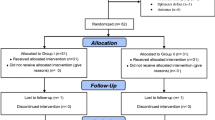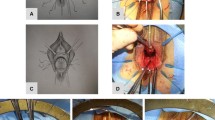Abstract
The most effective surgical technique for rectocele has not yet been clearly established. A retrospective multicentric study was carried out to compare the long-term results of 3 endorectal techniques (Block, Sarles and stapled) and the perineal levatorplasty, alone and in association, in a series of patients with symptomatic rectocele. From January 1992 to December 1999, 2212 patients with defecation disorders were referred to 5 Italian coloproctology units. An anterior rectocele was clinically diagnosed in 1045 patients and confirmed with defecography. On the basis of clinical and radiological parameters, 317 patients (312 women; mean age, 52.4±20.1 years) were selected for surgery. Group 1 consisted of 141 patients (136 women; mean age, 50.4±18.8 years) who were submitted to endorectal operations. Group 2 consisted of 126 women (mean age, 52.5±19.7 years) who received perineal levatorplasty. Finally, 50 women (mean age, 54.3±21.9 years) in Group 3 received endorectal operations associated with perineal levatorplasty. A total of 269 patients were followed postoperatively (mean period, 24.2±3.1 months, 27.5±5.4 months and, 22.8±2.8 months, respectively) with the same questionnaire and clinical examination. Three months after surgery, a defecography examination and anorectal manometry were performed in 136 and 132 patients, respectively. Operative time, hospital stay and time to return to work were significantly higher in Group 3 (p<0.001). There was one death in Group 3 due to severe sepsis. Main postoperative complications were: in Group 1, hemorrhage (7.8%, all Sarles), dehiscence of the endorectal suture (5.0%, all Block), distal rectal stenosis (2.1%, 1 stapled, 2 block), and rectovaginal fistula (1.4%, all Sarles); in Group 2, delayed healing of the perineal wound (16.4%); in Group 3 delayed healing of the perineal wound (22.0%), hemorrhage (6%, all Sarles), dehiscence (4.0%), stenosis (2.0%). 17.3% of patients of Group 2 and 22.5% of Group 3 complained of dyspareunia. Postoperative defecography showed a complete absence of the rectocele in 44.1% of patients and reduction of size in the others, without significant differences among the three groups. Manometric pattern was not significantly modified by surgery. Significant symptoms recurred in 5.9% of the patients in Group 1, 6.4% in Group 2, and 5.0% in Group 3. Perineal levatorplasty did not significantly improve obstructed defecation, as it did not allow to excise the rectal mucosal prolapse, and was followed by an high incidence of delayed healing of the perineal wound and dyspareunia. Sarles procedure achieved better control of mucosal prolapse but carried a higher complication rate compared to the others. The association of the perineal levatorplasty with an endorectal technique required significantly longer operative time, and led to a longer hospital stay and time to return to work. In conclusion, the investigated techniques showed different patterns of postoperative complications: bleeding after Sarles, dehiscence after Block, dyspareunia after perineoplasty and fatal gangrene after stapled, but non of them showed a clear superiority over the others in term of clinical or functional results 2 years after surgery.
Similar content being viewed by others
Author information
Authors and Affiliations
Additional information
Received: 28 September 2001 / Accepted in revised form: 16 November 2001
Rights and permissions
About this article
Cite this article
Boccasanta, P., Venturi, M., Calabrò, G. et al. Which surgical approach for rectocele? A multicentric report from Italian coloproctologists. Tech Coloproctol 5, 149–156 (2001). https://doi.org/10.1007/s101510100017
Published:
Issue Date:
DOI: https://doi.org/10.1007/s101510100017




